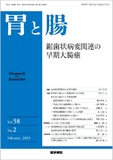Japanese
English
- 有料閲覧
- Abstract 文献概要
- 1ページ目 Look Inside
- 参考文献 Reference
要旨●癌併存大腸SSLについて,過去10年間に当院他で内視鏡的もしくは外科的切除された44病変を対象にNBI非拡大観察,拡大観察における特徴所見を検討した.発生部位は90%以上(40/44病変)が右側結腸であった.また平均腫瘍径は深達度別の差がなく,いずれも20mm前後であった.NBI非拡大所見では病変部全域に粘液が付着したred cap signを呈する病変が79.5%(35/44病変)でみられた.また癌化部位の肉眼型を隆起型と陥凹型に分け,その癌化部位が病変の中心部か辺縁部かも検討したところ.肉眼型では95.5%(42/44病変)と大部分で隆起型を呈し,癌化部位は79.5%(35/44病変)で病変辺縁部に認められた.NBI拡大観察ではSSLの特徴的所見とされている腺管開口部の開大所見(II-d pit)が95.5%(42/44病変)で認められた.また,JNET分類に基づく比較では,95.5%(42/44病変)で腫瘍性変化が確認でき,通常型の腺癌と同様に,深達度に応じて血管および表層の腺管構造に違いを認めた.以上から,NBI観察で病変の拾い上げおよびSSL由来の癌化病変の認識,深達度診断まで可能と結論付けられた.
WHO(World Health Organization)recommended the term “SSL(sessile serrated lesion)” was proposed by WHO in 2019. SSL, according to the several analyses, has a potential for malignant alteration. In this study, we studied 44 lesions identified as early colon cancer(Both intramucosal and invasive into submucosal layer)with SSL in past 10 years. These lesions were resected endoscopically or surgically and pathological sections were taken under the stereoscopy.
More than 90% cases were found in the right hemi-colon(cecum, ascending and transverse colon). Regardless of invasion depth, the mean diameter was about 20mm. We call the finding of the thickness of mucus covering the surface of the lesion the “red cap sign” by NBI(narrow band imaging)observation. This indication was seen in 79.5% cases. In 79.5% of cases, the malignant part of the lesion was identified at the tumor edge. In 95.5% lesions, the macroscopic appearance was a protruded shape. The finding of crypt dilatation was discovered indirectly through M-NBI(NBI observation with magnifying endoscopy). This is referred to as a “II-d(dilatation)pit.” This II-d pit was also seen in 95.5% lesions. 95.5% lesions were diagnosed as neoplastic change using JNET(the Japan NBI Expert Team)classification. Especially, 93.8%(30/32 lesions)of intramucosal lesions and slightly submucosal invaded cancers were diagnosed as JNET type 2A or 2B. Deeply submucosal invading tumors, on the other hand, were diagnosed as JNET type 2B or 3 This finding shows a good relationship to depth of invasion by M-NBI observation, similar to a normally tubular adenoma. As a result, NBI observation is good modality for detecting and diagnosing depth of invasion in early colon cancer(Both intramucosal and invasive into submucosal layer)with SSL.

Copyright © 2023, Igaku-Shoin Ltd. All rights reserved.


